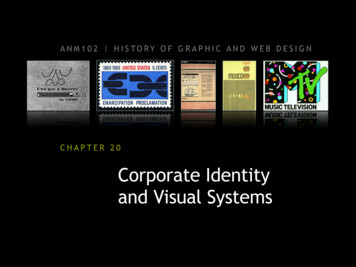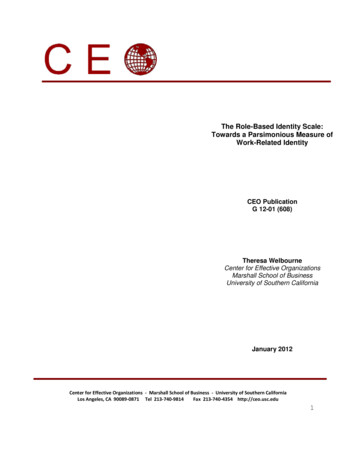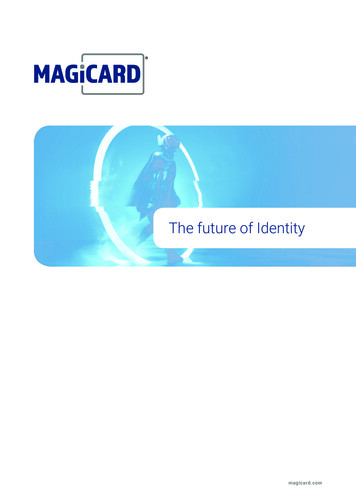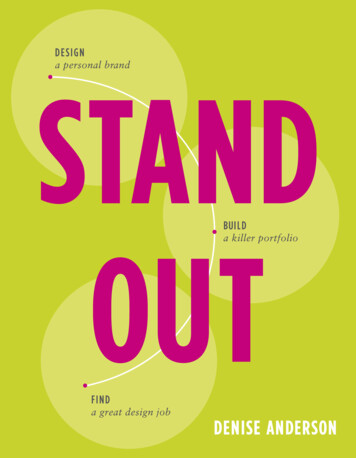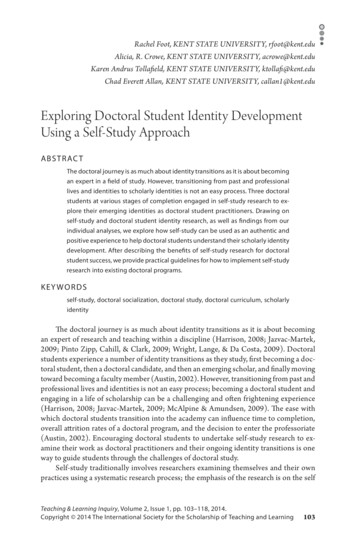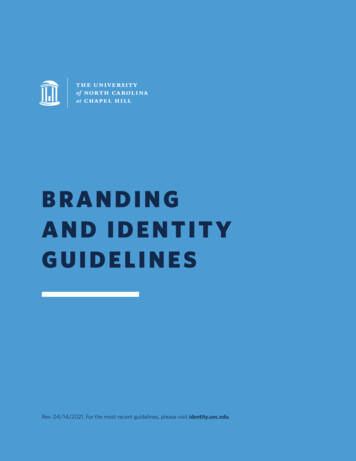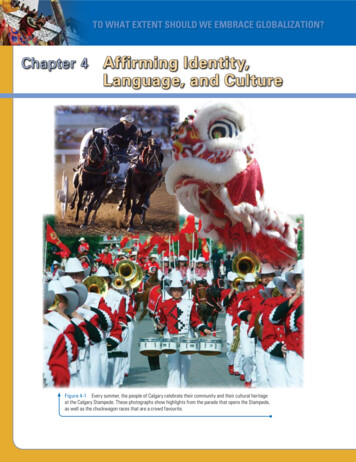
Transcription
TO WHAT EXTENT SHOULD WE EMBRACE GLOBALIZATION?Chapter 4Affirming Identity,Language, and CultureFigure 4-1 Every summer, the people of Calgary celebrate their community and their cultural heritageat the Calgary Stampede. These photographs show highlights from the parade that opens the Stampede,as well as the chuckwagon races that are a crowd favourite.
C HAP T E R IS S UETo what extent can people respond toglobalizing forces that affect identity?THE PHOTOGRAPHS of the Calgary Stampede on the previous page show anevent that Albertans — and hundreds of thousands of visitors — celebrateevery summer. Individuals and collectives from Calgary, from other parts ofAlberta, from Canada’s other provinces and territories, and from countriesaround the world celebrate together by sharing, affirming, and promotingtheir traditions, languages, and cultures.Examine the photographs on the previous page. Find and list elementsthat show people affirming their cultural identitythe traditions that are part of Alberta’s cultural heritagepeople sharing one another’s cultureways that community celebrations help people sharetheir culture the influences of global connections and interdependenceThink about the significance to cultural identity of communityevents like the Calgary Stampede. How do celebrations like thishelp bring communities together? How do these events reflect waysin which Albertans are responding to globalization?LOOKING AHEADKEY TERMScultural content lawscultural diversity‹‹‹In this chapter, you will explore answers to the following questions: How do people affirm and promote their language in a globalizingworld? How do people affirm and promote their culture in a globalizingworld? How do governments affirm and promote languages and cultures ina globalizing world? How do international organizations affirm and promote languagesand cultures in a globalizing world?PointMyof View on GlobalizationLook back at the notes you recorded as youbegan each of the previous three chapters.How have your understandings of globalizationchanged? Use words or images — or both — toanswer this question. Date your ideas and addthem to the notebook, learning log, portfolio, orcomputer file you are keeping as you progressthrough this course.89
VOICES Our own mother tongues are thingsin which we participate totally. Theychange our perception. So that ifwe spoke Chinese we would have adifferent sense of hearing, smell andtouch.— Marshall McLuhan, Canadianmedia expert who first used the term“global village”Language Groupsin Canada, 1991–2001Figure 4-2Designation199119962001Anglophone60.4% 59.8% 59.1%Francophone24.3% 23.5% 22.9%Allophone15.3% 16.6% 18.0%(people whose firstlanguage is a nonofficial language)Source: Statistics Canada, “Population andgrowth rate of language groups, Canada,provinces, territories and Canada less Quebec,1991, 1996, and 2001”HOW DO PEOPLE AFFIRM AND PROMOTE THEIRLANGUAGE IN A GLOBALIZING WORLD?To some people, language is identity. Language is so important to culturalidentity that peoples, governments, and organizations around the world usemany different strategies to affirm their language in a globalizing world.How important is your language to you? How does it shape your identity?People have always expressed their traditions, values, world views, andcultures through language. In Empires of the Word: A Language History ofthe World, language expert Nicholas Ostler wrote that written and orallanguages do more than just help people communicate with one another:“Even when they are unwritten, languages are the most powerful tools wehave to conserve our past knowledge, transmitting it, ever and anon, to thenext generation. Any human language binds together a human community,by giving it a network of communication; but it also dramatizes [thecommunity], providing the means to tell, and to remember, its stories.”Think about a typical day in your life. Up in the morning. Prepare forschool. Go to classes. See friends. Homework. TV. Bed. Choose a day andlist your activities. Beside each, indicate what role language played. Did you,for example, read the label on the juice box at breakfast? How many peopledid you speak to at school? What was the reason for each conversation?Keep this list for future reference.The table on this page shows the percentage of Canadians whosefirst language was English, French, or a language other than Canada’stwo official languages in three different years. What changes do thesestatistics show? How do you thinkglobalization has contributed to thesechanges? What changes do you thinkmight show up in statistics for 2006?For 2011?Differing ViewsFigure 4-3 Inuit people have alwayshanded down their culture andknowledge orally. This photographshows Inuit teacher Rhoda Ungalaqtelling students — in Inuktitut —about the quilluliq, the traditional lampused for cooking and warmth.90Some advocates of globalizationbelieve that increased communicationand interdependence will bringgreater understanding among thepeoples of the world. They say that ifeveryone speaks a common language,it could reduce the differences amongpeoples. Do you agree? If everyonespoke the same language, wouldfewer conflicts occur? What criteria might you use to make this prediction?Other people believe that though globalization provides opportunities,it also presents challenges. They believe that globalization threatenscultural diversity. As proof, they sometimes point to the growing number ofendangered languages. They believe that the challenge in a globalizing worldis to find ways to affirm and promote all languages and cultures.To what extent should globalization shape identity? MHR
Endangered LanguagesThe map on this page highlights two regions, the northwestern Caucasusand Vancouver Island, where languages have either disappeared or areendangered — at risk of disappearing.The number of languages spoken in the world declines every year.On average, one language disappears every two weeks. Language expertsbelieve that between 6000 and 7000 languages are spoken on Earth. Ofthese languages, 96 per cent are spoken by only four per cent of the world’speople. More than half these languages are endangered.Even linguists — people who study language — disagree over exactlyhow many languages exist and how many are in danger. How manylanguages can you name? You may be able to name the top three globallanguages in terms of number of speakers — Chinese, English, andSpanish — but it is much harder to know the total number of languages.There are many reasons for this. New languages are still being discoveredin remote regions. Some countries don’t keep track of the languages spokenby their citizens. And even if a country does keep track, people may disagreeover what is a separate language and what is a dialect — one of a group ofclosely related languages.VOICES We believe that, like our values, ourlanguages and the active use andexpression of them have the capacityto inspire our leaders, our Elders andyouth: to unite us in working towardour common goals. We are ourlanguage. Our language, culture andtraditions are inseparable.— A Treaty among Ourselves:Returning to the Spirit of Our Peoples,Assembly of First Nations RenewalCommission Report, 2005Why languages disappearLanguages can disappear when few people can speak them. When TevfikEsenç died in 1992, for example, the Ubykh language died with him. Hispeople had come from the northwestern Caucasus region that is now part ofRussia (see Figure 4-4). At one time, Ubykh was widely spoken in this area.But by the time Esenç died, even his three sons could not speak Ubykh.Before his death, Esenç wrote the inscription that he wanted placed on histombstone: “This is the grave of Tevfik Esenç. He was the last person ableto speak the language they called Ubykh.”Individuals and groups across Canada and around the world areworking to keep endangered languages alive. Aboriginal Elder Carrie Little,for example, teaches the Nuuc’aan’u, or Nootka, language to small groupsof her people on Vancouver Island. This language has been in decline formore than 100 years — and today, only a few hundred people speak andunderstand Nuuc’aan’u.Why does the numberof people who speak alanguage matter? BasedVancouver Islandon the stories of TevfikNuuc’aańu is in danger,Esenç and Carriebut people are keepingthis language alive byLittle, what do youmaking an effort tothink are some of thelearn to speak it.challenges faced bylanguage communitiesin a globalizing world?What do you think willhappen to the Nuuc’aan’ulanguage in the future?Vancouver Islandand the CaucasusFigure 4-4CaucasusUbykh disappeared withthe death of the lastperson who could speakthis language.MHR To what extent can people respond to globalizing forces that affect identity?91
VOICES Computer technology increases thefrequency of communication, whichcreates a desire to communicateacross boundaries. But the technologyalso enables communication inmultiple languages, using variousalphabets. In fact by 2020 we mightsee automatic translation systems.— Christian Huitema, wirelesscommunications developerFYIFor safety reasons, many people who workin international air travel and commercialshipping must have a working knowledgeof English. Both pilots and air trafficcontrollers must be able to work in English.And on large cargo ships that transportgoods across international waters, officersand engineers are required to have aworking knowledge of English.Figure 4-5 In 1998, a U.S.-basednon-profit organization took over thecontrol of the Internet. Why do youthink cartoonist Patrick Chappatte,along with other commentators, isconcerned about American control ofthe World Wide Web?92Dominance of EnglishAround the world, English has become the major language of business,scientific research, and popular culture. English is spoken by billions ofpeople in dozens of countries. English is also the main language of theInternet and the World Wide Web. How would this affect you if you didnot speak English? What challenges might you face in expressing youridentity and your culture?When computers first began to connect to the Internet, most users livedin English-speaking countries. Even in countries where English was not thefirst language, people who had access to the Internet were usually able tocommunicate in English. Accessing and understanding the Internet was notdifficult for people whose first or second language was English.The Internet was also designed to use the Roman alphabet (a, b, c, d,etc.), not characters like those in Arabic, Russian, Chinese, and Japanese.The result is that more than 90 per cent of the content on the Internet isnow in only 21 languages. Most of the speakers of the world’s more than6000 languages do not benefit from — and often do not have access to —the Internet.Christian Huitema, a wireless communications developer, believes thatbetter translation tools are a possible answer to this problem. Translationcannot, however, carry the meaning of many ideas and feelings that areexpressed in a language. Have you ever tried one of the translation toolsavailable on the Web? If so, what was the result?In addition, thousands of languages are just not represented on theInternet. Various internationalorganizations warn that if nothingis done to correct this situation,it will lead to a loss of culturaldiversity.But some people are predictingthat the dominance of Englishmay not continue. Around theworld, the number of people whogrow up speaking English as theirfirst language is declining. Inthe middle of the 20th century,nearly nine per cent of the world’spopulation grew up speakingEnglish. By 2050, this figure isexpected to drop to five per cent.In 2006, the world’s largest language group, in terms of first-languagespeakers, was Mandarin Chinese.What difference will it make if the number of people who speak Englishas a first language declines? Consider the countries where English speakersare being born. Where, in general, do these countries rate as world powers?In a globalizing world, which is more influential: the number of speakers ofa language or the dominance of a language group?To what extent should globalization shape identity? MHR
Magic CarpetIn this story, Mitali Perkins tells how her childhood need to assimilate intoWestern culture caused the loss of her first language, Bangla, and many ofher family connections.I had a magic carpet once. It used to soar to a world of monsoon storms,princesses with black braids, ferocious dragons, and talking birds.“Ek deen chilo akta choto rajkumar,” my father would begin, andthe rich, round sounds of the Bangla language took me from ourcramped New York City apartment to a marble palace in ancientIndia.Americans made fun of my father’s lilting accent and thestrange grammatical twists his sentences took in English.What do they know? I thought, perching happily besidehim.In Bangla, he added his own creative flourishes toclassic tales by Rabindranath Tagore or Sukumar Roy. Heembellished folktales told by generations of ancestors,making me chuckle or catch my breath. “Tell anotherstory, Dad,” I’d beg.But then I learned to read. Greedy for stories, I devouredbooks in the children’s section of the library.In those days, it was easy to conclude that any tale worthpublishing originated in the so-called West, was written inEnglish, and featured North American or European characters.Slowly, insidiously, I began to judge my heritage throughcolonial eyes. I asked my mother not to wear a sari, her traditionaldress, when she visited me at school.I avoided the sun so that the chocolate hue of my skin couldn’t darken.The nuances and cadences of my father’s Bangla began to grate on my ears.“Not THAT story again, Dad,” I’d say. “I’m reading right now.”My father didn’t give up easily. He tried teaching me to read Bangla, but I wasn’tinterested. Soon, I no longer came to sit beside him, and he stopped telling storiesaltogether.As an adult, I’ve struggled to learn to read Bangla. I repudiate [argue against] anydefinition of beauty linked to a certain skin color. I’ve even lived in Bangladesh toimmerse myself in the culture.These efforts help, but they can’t restore what I’ve lost. Once a child relinquishesher magic carpet, she and her descendants lose it forever.Figure 4-6 Mitali Perkins was born inKolkata, which was formerly known asCalcutta. Her family lived in Cameroon,Ghana, Mexico, and New York beforesettling in San Francisco.REFLECT AND RESPOND“The loss of a language is more than the loss of theability to communicate with others.” Explain what thisstatement means. How does Mitali Perkins’s storyillustrate this statement?In groups, brainstorm to create a list of reasons whylanguages have been lost. In your session, talk aboutthe consequences for the identity of members of alanguage group when their language is lost. Then listfour positive steps that members of a group might taketo affirm their language and identity.MHR To what extent can people respond to globalizing forces that affect identity?93
FOCUS ON SKILLSPREDICTING LIKELYOUTCOMESFOCUS ON SKILLSAround the world, the number of people who speak Indigenous languages is dropping. An Indigenouslanguage is one that originated in a specific place and was not brought from somewhere else. Variousindividuals, groups, and organizations are trying to stop this language decline.Consider this question: How successful will efforts to save the world’s endangered languages be?No one can know the answer to this question. But to do something about the situation, peopleneed to develop informed opinions. How would you develop a prediction that is informed and isbased on reliable factual evidence?The following steps can help you conduct research to develop an informed prediction in responseto the question. As you progress through this course, you can use these steps to help you makepredictions in response to other questions.Steps to Predicting Likely OutcomesStep 1: Review prior knowledgeWhen researching to predict what is likely to happenin the future, the present is a good place to start. Think about what you already know. You might startby making notes on the section of this chapter thattalked about Indigenous languages. Think about your own experience. The language youspeak at home, for example, may not be English. Youmay take language learning classes outside school,or you may have discussed the life of the languagewith Elders or teachers. What is your point of view as you start this inquiry?You may believe, for example, that Canada is notdoing enough to save endangered languages. Or youmay not have formed an opinion yet.Step 2: Establish criteria for making judgmentsEstablish criteria for judging whether efforts to saveendangered languages will be successful. You canexpress these criteria as questions (e.g., Is the numberof speakers of endangered languages rising? What dopeople who have studied the issue say?).You may wish to check the prologue to reviewstrategies for developing criteria.Step 3: Create a point-proof-comment organizerA point-proof-comment organizer can help you prepareto make and back up a prediction.On a sheet of paper or in a computer file, createan organizer like the one shown here. Repeat thepoint-proof-comment pattern several times. Use a fullpage so you will have plenty of room for writing andthinking through the evidence you gather. An exampleis provided below.How successful will efforts to save the world’sendangered languages be?Research Source 1: Exploring Globalization (page 91)PointMany languages are endangeredbecause few people speak them.Proof96% of endangered languages arespoken by only 4% of the world’speople.CommentMore people need to be encouragedto learn to speak endangeredlanguages.Research Source 2:PointRESEARCH TIPRemember that your criteria — and question — can change.As you conduct your research, you may want to alter yourcriteria to reflect your changing point of view.94To what extent should globalization shape identity? MHRProofComment
FOCUSFOCUSON SKILLSONFOCUS ON SKILLSFOCUS ON SKILLSFOCUS ON SKILLSFOCUS ON SKILLSFOCUS ON SKILLSStep 4: Conduct researchExamine the sources on this page. As you review each,ask, What do I think? How does this information meetmy criteria for judgment?You will also need to conduct other research.Where could you locate a variety of relevant, useful,up-to-date resources? Consider the kind of data youneed. For example, do you want numerical data? Thenthe Statistics Canada web site may be the place to go.Record a point, a proof, and a comment on theevidence the source offers.Summing upReview your criteria. Do you need to change any ofyour questions? Review your notes and point-proofcomment organizer. Which arguments are mostreliable and authoritative? Reflect on your findings andwhether your position has changed since you started.Write a paragraph that states your prediction,explains why you are making it, and supports it withreliable evidence. If you can’t make a prediction,explain why not. Edit your paragraph until it clearlysays exactly what you want it to say.Source 1 According to the Worldwatch Institute,an international research organization, many of theworld’s Indigenous languages are endangered.Source 3 Mark Abley, a Canadian writer, studieslanguages. In his book Spoken Here: Travels amongThreatened Languages, he talks about the Hebrewlanguage, which is used in everyday life in Israel: inschools, in government, on television and radio, insongs and theatres. In the 1995 census, 4 510 000people in Israel — or 63 per cent of the population —spoke Hebrew.More than half of the world’s 7000 languages areendangered, and nearly 550 languages are spokenfluently by fewer than 100 people, increasing thelikelihood that they will disappear quickly. Of these, 516are considered nearly extinct. A language is classifiedas nearly extinct when the speaker population is fewerthan 50 or when the number of speakers represents avery small fraction of an ethnic group.Source 2 Statistics Canada reports that, in 1996,29 per cent of Aboriginal peoples in Canada saidthey had enough knowledge of an Aboriginal languageto carry on a conversation. By 2001, this figure haddropped to 24 per cent (see Figure 4-7).Figure 4-7AboriginalLanguageSpeakersin CanadaAboriginal h languages not included elsewhereAlgonquinDogribCarrierIn 1880 no child in the world spoke Hebrew as a firstlanguage. Although it had a rich vocabulary, Hebrew wasa sacred language that was used mainly for prayer andrecitation. Today, after many years of determined efforts bythe Jewish people to revitalize and modernize the language,Hebrew is the official language of Israel.Speakersin 199695 55529 40029 akersin 200192 63031 94527 95510 50010 .1–8.4–6.8–29.3Source: Statistics Canada, “Aboriginal-identity population with knowledge of an Aboriginal language and with an Aboriginallanguage as mother tongue, for selected languages with 2,000 or more speakers, Canada, 1996 and 2001.”MHR To what extent can people respond to globalizing forces that affect identity?95
HOW DO PEOPLE AFFIRM AND PROMOTE THEIRCULTURE IN A GLOBALIZING WORLD?Figure 4-8 The Ukrainian HeritageVillage near Edmonton affirms theculture and heritage of people whocame to Alberta from Ukraine. How dosites like this promote a community’sculture in a globalizing world?VOICES One culture after another, we are allbeing fed into an industrial-strengthblender, and we all come outchanged. What would a global culturemean? It would mean that the worldgoes on speaking 50 major languagesand hundreds of little ones, butincreasingly it talks about the samethings from the same perspectives inall of them.— Gwynne Dyer, columnist andfilmmaker, in Millennium, a seriesproduced for CBC Radio96When you affirm your identity, you strengthen your sense of self throughyour personal expressions. When the descendents of people who cameto Alberta from Ukraine created a heritage village (see Figure 4-8), theystrengthened their collective identity. Collectives affirm their identity whenthey speak theirlanguage or expresstheir culture,nation, or gender.But how doesglobalization affectcollective culturalidentity? Howcan people affirmtheir culture andavoid being fedinto what GwynneDyer calls “theindustrial-strength blender” (see Voices on this page)?Some people affirm their cultural identity by reclaiming what has beenlost. In 2006, for example, the Haisla people of British Columbia reclaimeda totem pole, called the G’psgolox pole, from the National Museum ofEthnography in Stockholm, Sweden. The totem pole had been taken fromthe Haisla in 1927.The Na na kila Institute of the Haisla Nation explained what thereturn of the G’psgolox pole meant: “This totem represents so much morethan just a monument; it is symbolic of our character, our integrity, ourfortitude, and our identity as a nation. We are no longer frozen in time orput on display for others to see; this repatriation process reminds all that asa nation, we are present and active participants in our societies today.”Other people affirm their cultural identity by helping others promotetheir culture. The Krymsky Education Society of Edmonton, for example,is an organization of Albertans of Ukrainian descent and is helping Tartarpeople revitalize their culture and language.The Tartar people live in the Crimean region of Ukraine, andUNESCO — the United Nations Educational, Scientific and CulturalOrganization — lists their language as “seriously endangered.” Thelanguage’s status as endangered results partly from the fact that, after threecenturies of Russian rule, the major language in the region is Russian. Atthe end of World War II, the Crimean Tartar language and culture werefurther weakened when Soviet dictator Joseph Stalin exiled about 200 000Tartars to Central Asia. Because there are fewer Tartar speakers today thanthere once were, there are not many schoolbooks in the Tartar language.On the other side of the world, the Krymsky Education Society ofEdmonton is helping revitalize the Tartar culture by producing bilingualUkrainian and Tartar textbooks for children in the Crimea.To what extent should globalization shape identity? MHR
Cultural Revitalization — Challenges and OpportunitiesCultural revitalization is one way for a nation or a people to keep theircultural identity from being absorbed into the “industrial-strength blender”of globalization.Douglas Cardinal’s design for the First Nations University of Canada(see Figure 4-9) preserves the past at the same time as the institution offersopportunities for future generations. The past is represented in the designof the building, which revitalizes aspects of traditionalFirst Nations architecture.The cultural treasures of many Aboriginal peopleshave survived in museums in Canada and around theworld. These objects, or artifacts, include clothing,tools, jewelry, historical documents, and photographs.Though some of these artifacts were obtained legally,others were not.Many of the Aboriginal artifacts on display in thesemuseums have spiritual significance to the Aboriginal peoplefrom whom they were acquired. Slowly, over the years, museumshave started to return these treasures to their original owners:Aboriginal peoples.IdeasFigure 4-9 Canadian Aboriginalarchitect Douglas Cardinal designed theFirst Nations University of Canada inRegina, Saskatchewan, in consultationwith First Nations Elders. First Nationspeoples run the university. How do youthink this university represents both thechallenges and the opportunities thatFirst Nations young people face in aglobalizing world?Should museums return Aboriginal artifacts to the people who originallycreated and used them?The students responding to this question are Deven, who was born inIndia but is now a Canadian who lives in Calgary; Gord, a member ofthe Beaver First Nation near High Level; and Katerina, who lives inSt. Albert and whose grandparents emigrated from Ukraine in 1948.DevenYour TurnGordKaterinaHow would you respond to the question Deven, Gord, and Katerinaare answering? Explain the reasons for your answer. What aspects ofyour own experience and your own background influence the way yourespond to this question?MHR To what extent can people respond to globalizing forces that affect identity?97
IMPACTLADAKH —RESPONDING TO GLOBALIZATIONIMPACTWhen the remote Indian region of Ladakh was opened to tourists in the early 1970s, Dolma Tseringwas alarmed. Over the next decades, she watched as her fellow Ladakhis embraced the values thatarrived with the tourists.To Tsering, it seemed as if Ladakhis were slowly butsurely losing their distinctive identity and culture.But then, things began to change — and today,Tsering, who leads the Women’s Alliance of Ladakh, isoptimistic about her people’s ability to shape their ownfuture in their own way.“For a while,” Tsering told an interviewer, “we inLadakh lost respect for ourselves and for our culture.But now we know we have no reason to feel inferior.Now we feel more confident about who we are. In fact,we know now that the world can learn a lot from us.It is important that our young people understand that.There is much that Ladakh can teach the world.”Living in LadakhLocated high in the Himalaya Mountains, Ladakh is partof the northern Indian state of Jammu and Kashmir.About 200 000 Ladakhis exist in one of the harshestlivable environments in the world. Ladakh is coveredin snow for about eight months of the year — and theextreme altitude, cold, and isolation helped create aunique, self-sufficient culture that thrived for centuries.Ladakh RegionFigure 4-10teL a d a Ladakhkh RanZansgekarRanSrinagarLehgerHimangeRaea(Claimedby China)morarakGrKaPa k i s t a nCh inaJammu andKashmirlayanRangTibete100200kilometres98300New Economic OpportunitiesThe opening of the highway brought new economicopportunities to the region. Ladakhis found muchlarger markets. India, for example, began to buy largeamounts of barley and grain. In addition, adventuretourism and trekking brought in even more money andsignificantly increased the income of many Ladakhis.And cheap imported food and products have becomewidely available, especially in Leh, the region’sbiggest town.In addition, Amchi, a traditonal herb- and mineralbased medicine, has attracted the attention of theoutside world. The ancient knowledge of Amchi isnow being studied by other medical systems, such asIndia’s, to see how it can benefit others.Globalization Comes to LadakhI nd i a0Ladakhis remained isolated from the outside worldfor much longer than most other Indigenous cultures.Before a highway was opened in 1962, the onlyway to reach the area was to hike through narrowmountain passes. Even after the highway was built,the Indian government barred tourists from enteringLadakh because of a continuing border dispute withneighbouring China.Despite its isolation, Ladakh was influenced byoutside forces. Both Buddhism and Islam, the chiefreligions of most of the people, were imported fromother regions. And Ladakhi men had always travelledto sell their products — primarily jewelry, salt, anddried fruit — and to buy goods, such as sugar andtea, which they cannot grow themselves.LegendState CapitalHighwayNepalTo what extent should globalization shape identity? MHRAs the world found out about Ladakh — and Ladakhfound out about the world — the region faced manychallenges. Helena Norberg-Hodge, a Swedishactivist, was one of the first to document the effectsof contact on Ladakhis. She wrote that, before the1970s, Ladakh had developed a highly independentculture based on agriculture. People produced asurplus that they sold for enough money to buyluxuries, such as jewelry. Wom
We believe that, like our values, our languages and the active use and expression of them have the capacity to inspire our leaders, our Elders and youth: to unite us in working toward our common goals. We are our language. Our language, culture and traditions are inseparable. Ñ A Treaty among Ourselves:

